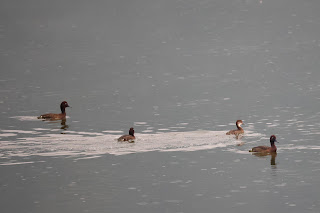Maddeningly, it was another day consisting of mostly driving. We set off from Antsohihy at 04:00 in the morning, finally arriving in the town of Belanana at 09:30. The road here was very bad in several areas, and this slowed us down significantly, although not as much as what was to follow. After a quick supply run in Belanana, we were finally on the road to Benamevika at around 10:30, and initially made good progress, at least better than we were expecting. Sadly, we soon discovered why all the trip reports warned us of this road. Between the many deep ruts, full puddles, broken bridges and crossing moving waterways, we lost a great deal of time and only finally managed to arrive at 15:00.
Although this obviously cost us a great deal of time, we still picked up a few bits as we drove through areas of habitat. While repairing a makeshift bridge we managed to tape in a Dark Newtonia, a bird that had frustratingly eluded us so far on this trip. Sadly all our equipment was still packed away at this point, but the bird was quite confiding and very vocal, meaning we had no qualms about the identification. Also here was a very smart Malthe's Green-eared Chameleon right by the side of the road, another new Chameleon species for our trip. Once we drove through more open habitat, we also had many nice views of Madagascar Stonechat.
Despite this, we still made it out birding in the afternoon, just in time to be hit by a tropical storm. We decided to first try for the Madagascar Pochard, which only occurs on a few lakes in this area, after its rediscovery following its declared extinction. The bird was surprisingly easy and showed very well. We took a trail from the road just up from the camp, through an area of forest, and then to a small watchtower on the edge of the lake. From the tower, we saw somewhere between 8 – 10 different individuals, including males and females. We were even able to watch birds displaying to each other, and small groups performed multiple flybys. Not bad for a bird considered extinct less than 20 years ago.
Also on the lake, there were several other nice waterbirds. The Mellers Duck showed nicely on occasion and we also had a pair showing well near the campsite as we pitched our tent. Madagascar Grebe was very abundant, and there was a pair of these regularly displaying in front of the tower, offering absolutely brilliant views. Otherwise, commoner species included Red-billed Teal and White-faced Whistling Duck. Because of the rain, the forest was almost silent, but we did have a small group of Common Brown Lemur mob us as we passed.
Absolutely exhausted, we returned to camp just after dark, had a small bite to eat and headed to bed, to prepare ourselves for the following days intense birding.
Benamevika: White-faced Whistling Duck, Meller's Duck, Red-billed Teal, Madagascar Pochard, Common Quail, Madagascar Grebe, Malagasy Coucal, Madagascar Cuckoo, Madagascar Nightjar, Common Moorhen, Madagascar Buttonquail, Purple Heron, Madagascar Buzzard, Olive Bee-eater, Lesser Vasa Parrot, Dark Newtonia, Madagascar Cisticola, Malagasy Brush Warbler, Madagascar Swamp Warbler, Mascarene Martin, Madagascar Stonechat, Malagasy Green Sunbird, Red Fody,















No comments:
Post a Comment